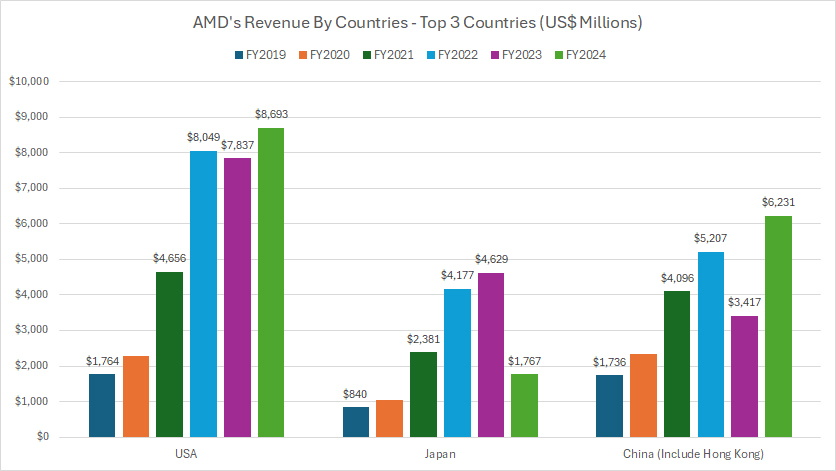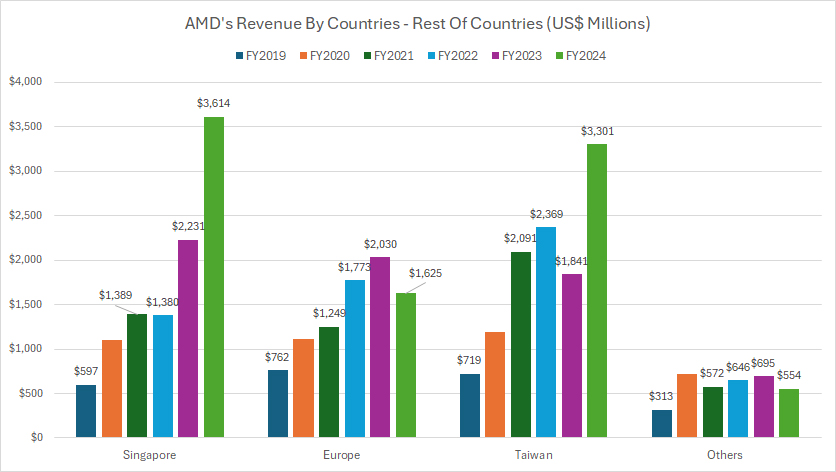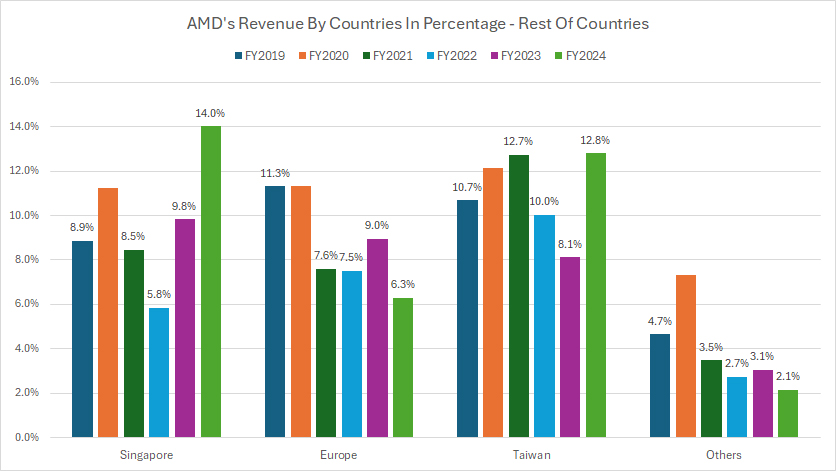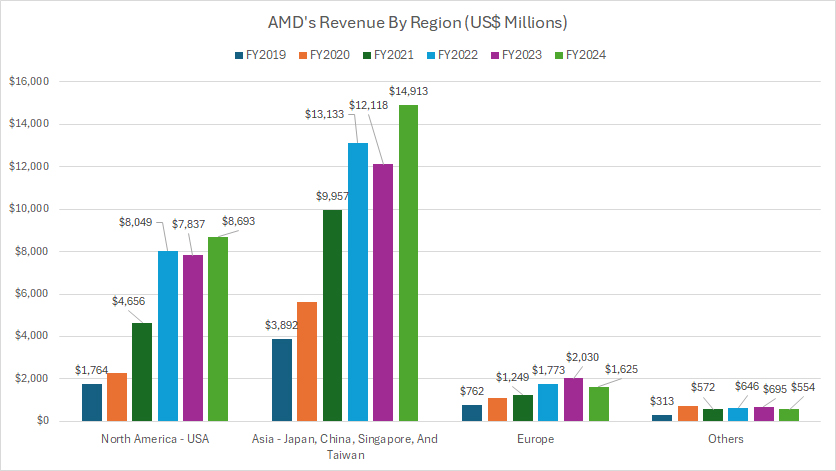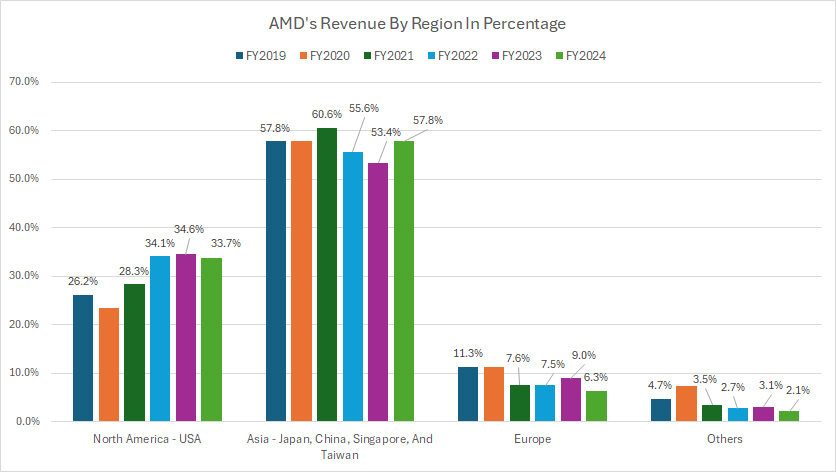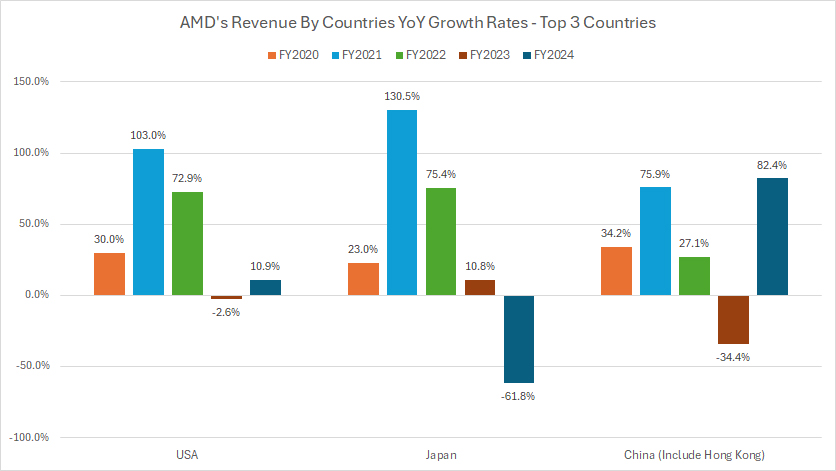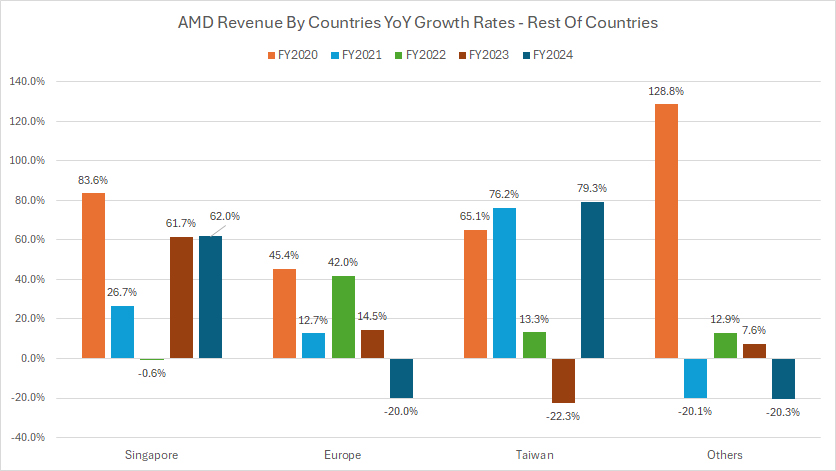
Server racks. Pexels Images.
This article looks at Advanced Micro Devices (AMD)’s revenue by country and by region. AMD derives its revenue from only a handful of countries, with the majority of it coming from the USA.
However, the bulk of AMD’s revenue is generated in Asia, with Japan being its largest revenue source and China being the second.
Without further delay, let’s look at the numbers!
Investors interested in AMD’s other key statistics may find more resources on these pages:
- AMD revenue breakdown: data center, gaming, client, etc.,
- AMD vs Nvidia: profit margin analysis, and
- AMD profit margin by segment: embedded, data center, client, etc..
Please use the table of contents to navigate this page.
Table Of Contents
Definitions And Overview
O2. Why is AMD getting the majority of its revenue from the U.S.?
Revenue By Country – Top 3
A1. Revenue From The USA, Japan, And China
A2. Percentage Of Revenue From The USA, Japan, And China
Revenue By Country – Rest Of World
B1. Revenue From Singapore, Europe, And Taiwan
B2. Percentage Of Revenue From Singapore, Europe, And Taiwan
Revenue By Region
C1. Revenue From North America, Asia, And Europe
C2. Percentage Of Revenue From North America, Asia, And Europe
Revenue YoY Growth Rates
D1. YoY Growth Rates Of Revenue From The USA, Japan, And China
D2. YoY Growth Rates Of Revenue From Singapore, Europe, And Taiwan
Summary And Reference
S1. Insight
S2. References and Credits
S3. Disclosure
Definitions
To help readers understand the content better, the following terms and glossaries have been provided.
Revenue By Country: According to AMD’s fiscal year 2024 annual report, AMD defines its revenue by geographic region as revenue allocated to individual countries based on the billing location of the customers.
Therefore, the geographical locations are not necessarily indicative of the country in which the customer sells products containing AMD’s products.
Why is AMD getting the majority of its revenue from the U.S.?
AMD’s revenue dominance in the U.S. stems from several strategic and market-driven factors:
-
Data Center and Enterprise Market: AMD’s EPYC processors and Instinct accelerators are widely adopted by major U.S.-based cloud service providers and enterprises. These products cater to the growing demand for high-performance computing and AI workloads, which are heavily concentrated in North America.
-
Client Computing: AMD’s Ryzen processors are popular among U.S. consumers and businesses for personal computing and gaming. The U.S. market’s appetite for cutting-edge technology drives significant sales.
-
Strategic Partnerships: Collaborations with U.S.-based tech giants like Microsoft and Google enhance AMD’s visibility and integration into key platforms, further boosting its revenue.
-
Fabless Model: AMD’s fabless manufacturing strategy allows it to focus on design and innovation while leveraging global foundries like TSMC. This model supports scalability and efficiency, particularly in meeting U.S. demand.
-
Innovation and Diversification: AMD continuously expands its product lineup, including GPUs and adaptive SoCs, catering to diverse applications from gaming to professional workloads.
While the U.S. remains a major revenue source, AMD also generates substantial income from Asia, with Japan and China being key markets. This global footprint reflects AMD’s balanced approach to growth.
Revenue From The USA, Japan, And China
AMD-revenue-by-country-top-3
(click image to expand)
The definition of AMD’s revenue by country is available here: revenue by country. The top 3 countries contributing the highest revenue to AMD were the United States, Japan, and China.
The United States was AMD’s largest source of revenue. The USA has contributed an average of $8.2 billion in revenue annually to the company from fiscal year 2022 to 2024. In fiscal year 2024, AMD’s revenue from the United States reached a record figure of $8.7 billion, a significant increase from the $7.8 billion reported in 2023.
Japan used to be AMD’s second largest revenue source, contributing an average of $3.7 billion in revenue annually to the company since 2021. In fiscal year 2023, AMD generated a record figure of $4.6 billion in revenue from Japan, up 11% over the prior year.
However, in fiscal year 2024, AMD’s revenue from Japan plummeted considerably to only $1.8 billion, down by more than 50% from the $4.6 billion reported in 2023, making this country a less significant revenue contributor for the company.
China, excluding Taiwan but include Hong Kong, was AMD’s third largest revenue source. Since 2021, China has contributed an average of $4.2 billion annually to the company. In fiscal year 2023, AMD generated $3.4 billion in revenue from China, down more than 30% from a year ago.
However, in fiscal year 2024, AMD’s revenue from China surged to $6.2 billion, up by nearly 100% from $3.4 billion reported in 2023, making China the second largest revenue contributor to the company, significantly overtaking Japan.
Percentage Of Revenue From The USA, Japan, And China
AMD-revenue-by-country-in-percentage-top-3
(click image to expand)
The definition of AMD’s revenue by country is available here: revenue by country. The top 3 countries contributing the highest revenue to AMD were the United States, Japan, and China.
From the perspective of percentage, the United States has contributed the highest portion of revenue to AMD in most fiscal years, accounting for more than 30% of the total.
In fiscal year 2024, the sales percentage from the U.S. reached nearly 34%, the largest among all countries compared. Since fiscal year 2019, AMD’s revenue portion from the U.S. has risen from 26% to the latest result of 34%, marking the U.S. as one of the most dominant revenue driver for the company.
Japan’s sales contribution has steadily risen since fiscal year 2019, reaching 20% in fiscal year 2023, the highest level ever recorded for this country, as shown in the chart above. However, in fiscal year 2024, it tumbled to only 7%, due to the significant plummet of the revenue from this country in the same year.
In contrast, the revenue contribution from China surged to 24% in fiscal year 2024 from 15% a year ago, making China the second largest revenue driver for AMD, second only to the U.S.
Revenue From Singapore, Europe, And Taiwan
AMD-revenue-by-country-rest-of-world
(click image to expand)
The definition of AMD’s revenue by country is available here: revenue by country. The rest of the countries contributing significant revenue to AMD were Singapore, Europe, and Taiwan.
Singapore ranks fourth in terms of one of the largest revenue streams to AMD. In fiscal year 2024, AMD’s revenue from Singapore reached a staggering figure of $3.6 billion, nearly double the amount from a year ago.
Not far behind Singapore was Europe, whose revenue contribution topped $1.6 billion in fiscal year 2024. Taiwan is another region significantly contributing sales to AMD, with figure surging to $3.3 billion in fiscal year 2024, even surpassing that from Europe.
On average, Taiwan has contributed a record figure of $2.5 billion in annual revenue since fiscal year 2022 to the company.
Percentage Of Revenue From Singapore, Europe, And Taiwan
AMD-revenue-by-country-in-percentage-rest-of-world
(click image to expand)
The definition of AMD’s revenue by country is available here: revenue by country. The rest of the countries contributing significant revenue to AMD were Singapore, Europe, and Taiwan.
The revenue contribution from Singapore to AMD topped 14% of the total in fiscal year 2024, up significantly from 10% measured in 2023.
AMD generated about 9% of sales from Europe in fiscal year 2023, while Taiwan provided 8% of the total in the same period. In fiscal year 2024, AMD’s revenue from Europe tumbled to just 6%, while that from Taiwan surged to 13%, significantly outpacing Europe.
A significant trend was that the revenue contribution from Europe to AMD has significantly declined since 2019, from nearly 11% in 2019 to just 6% as of 2024.
Revenue From North America, Asia, And Europe
AMD-revenue-by-region
(click image to expand)
The definition of AMD’s revenue by country is available here: revenue by country.
From a regional perspective, AMD derives the largest portion of its revenue from Asia, as illustrated by the chart. This dominance reflects Asia’s critical role in AMD’s global operations and demand for its products across countries like Japan, China, Singapore, and Taiwan.
These markets are not only vital for consumer electronics and computing products but also serve as hubs for manufacturing and supply chain activities. AMD’s collaborations and product penetration within Asia underline its strategic emphasis on the region.
While the United States has historically been AMD’s single largest source of revenue due to robust demand from data centers, enterprises, and individual consumers, its contribution is significantly overshadowed by Asia. In fiscal year 2024, AMD’s revenue from Asia soared to nearly $15 billion, solidifying its position as the most important region in AMD’s revenue distribution.
In contrast, revenue from North America reached $8.7 billion during the same period — a sizable figure but far short of Asia’s contribution.
Europe, meanwhile, plays a relatively minor role in AMD’s regional revenue composition. In fiscal year 2024, AMD’s revenue from Europe was slightly above $1.6 billion, showcasing a smaller market impact when compared to Asia and North America. This disparity could be attributed to regional market dynamics, lower consumer demand for AMD’s product lineup, or a higher concentration of competitors within Europe.
This geographical breakdown emphasizes AMD’s reliance on Asia as a cornerstone of its financial performance while maintaining significant contributions from North America. It also highlights the potential for growth in less-represented regions, such as Europe.
Percentage Of Revenue From North America, Asia, And Europe
AMD-revenue-by-region-in-percentage
(click image to expand)
The definition of AMD’s revenue by country is available here: revenue by country.
In fiscal year 2024, AMD derived 34% of its total revenue from North America, demonstrating the region’s ongoing significance as a key market.
However, Asia accounted for a much larger share, contributing 58% of AMD’s total revenue during the same period — making it the highest among all regions compared. This underscores the importance of Asian markets, particularly given the technology demand in countries like China, Japan, and Taiwan.
To put it into perspective, in fiscal year 2024, more than half of AMD’s revenue originated from Asia, a testament to the region’s robust and consistent performance. A noteworthy trend is the stability of Asia’s revenue share, which has hovered at similar levels from fiscal year 2019 through 2024.
This consistency highlights AMD’s solid foothold in the region, likely bolstered by strong partnerships, demand for semiconductor solutions, and the presence of manufacturing and supply chain networks.
In contrast, Europe contributed just 6% to AMD’s revenue in fiscal year 2024, reflecting its relatively smaller market presence in the region compared to Asia and North America. This could be attributed to factors like differing market dynamics, competition, and regional demand for AMD’s product portfolio.
YoY Growth Rates Of Revenue From The USA, Japan, And China
AMD-revenue-by-country-yoy-growth-rates-top-3
(click image to expand)
The definition of AMD’s revenue by country is available here: revenue by country.
In terms of revenue YoY growth, we can see from the chart that the U.S. and Japan has done pretty well in most fiscal year since 2020. From fiscal year 2020 to 2024, AMD has managed to grow its revenue from the U.S. by an average growth rate of 27% annually. In fiscal year 2024, AMD’s revenue growth in the U.S. topped 11% over 2023.
Similarly, AMD’s revenue growth in Japan has been quite decent. For example, since 2020, AMD’s revenue growth in Japan has averaged 8% annually, although revenue growth in fiscal year 2024 declined by 63% year-over-year.
Among the three countries compared, AMD’s China has experienced the most robust revenue growth. On average, AMD has grown its revenue from China by 25% annually since 2020. Unfortunately, AMD’s revenue growth in China was a staggering decline of more than 30% in fiscal year 2023. However, in 2024, AMD’s China growth came roaring back, with a YoY growth rate surging to 82%, the highest than any countries compared.
YoY Growth Rates Of Revenue From Singapore, Europe, And Taiwan
AMD-revenue-by-country-yoy-growth-rates-rest-of-world
(click image to expand)
The definition of AMD’s revenue by country is available here: revenue by country.
AMD’s revenue growth in Singapore topped 62% in fiscal year 2024 and has averaged 41% annually since 2020.
AMD achieved revenue growth of about 12% annually on average in Europe, while the average annual growth rate from Taiwan was 23% since 2020.
Similar to China, AMD saw robust revenue growth in Taiwan in fiscal year 2024, with the YoY growth rate amounting to 79%, one of the highest among all countries compared.
Insight
The geographical breakdown of AMD’s revenue underscores the company’s reliance on Asia as a cornerstone of its financial performance while maintaining significant contributions from North America. It also highlights potential growth opportunities in underrepresented regions like Europe.
References and Credits
1. All financial figures presented were obtained and referenced from AMD’s quarterly and annual reports published on the company’s investor relations page: AMD Financial Reports.
2. Pexels Images.
Disclosure
We may use artificial intelligence (AI) tools to assist us in writing some of the text in this article. However, the data is directly obtained from original sources and meticulously cross-checked by our editors multiple times to ensure its accuracy and reliability.
If you find the information in this article helpful, please consider sharing it on social media. Additionally, providing a link back to this article from any website can help us create more content like this in the future.
Thank you for your support and engagement! Your involvement helps us continue to provide high-quality, reliable content.


